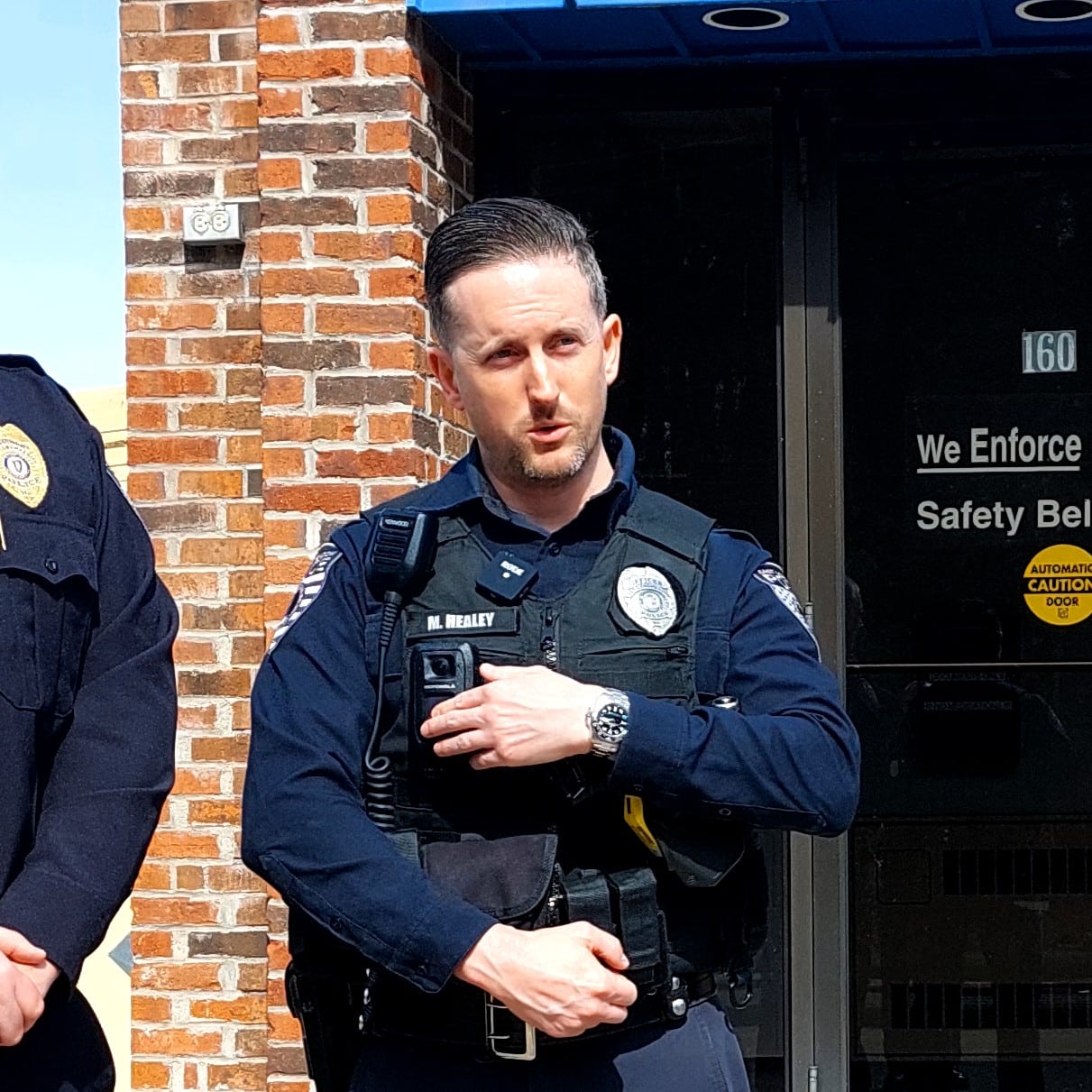Officer Michael Healey demonstrated how to activate the body cameras.
Reminder Publishing photo by Sarah Heinonen
EAST LONGMEADOW — East Longmeadow police officers have a new tool to help them increase officer protection and accountability to the community. The department went live with body cameras on March 10.
“Body-worn cameras are widely recognized as a best-practice in the policing profession. They provide the best objective documentation possible of police and citizen encounters,” Police Chief Mark Williams said in a press release. I am thankful for their commitment to professionalism to providing the best policing services possible to the public we serve.”
The Motorola V700 cameras, worn on the chest of each uniformed officer, are lightweight and relatively small — slightly larger than a deck of playing cards and twice the thickness. Lt. Steve Manning explained that the camera is “always on,” recording video without audio, but the recordings are discarded after 30 seconds. When an officer approaches someone in the course of their duties or is booking a prisoner, they press a button to activate the device. It will then save the previous 30 seconds of inactive video and begin recording with audio.
According to Motorola, the camera’s field of view for is 130 degrees horizontal, 73 degrees vertical and 149 degrees diagonal. Williams said it can “see” slightly less than the average person’s peripheral vision. A small screen on the top of the device is linked to the department’s computer system and records the type of call being answered by the officer, which determines how long a video must be maintained.
Manning received training from the product vendor and went on to train the department’s officers in how to use the cameras, when to activate them and their responsibilities regarding the units.
Each officer is assigned a camera when they join East Longmeadow’s police force, and that unit is theirs for the entire time they work in the department. At the end of each shift, officers are required to dock their cameras in charging stations, which also triggers all video to be uploaded to a secure platform. Williams and Manning can review any video file. Generally speaking, officers are allowed to review only what was captured on their own device. The district attorney’s office and defense attorneys also have access to recordings.
Williams said the videos are part of the public record and can be requested through a public records request. However, depending on the type of call captured in the recording, some of it may be redacted, such as in the case of a domestic dispute, medical calls or content involving minors.
When Williams was hired as the chief four years ago, he was interested in outfitting the department with cameras. After negotiating over the cameras with the police union, the department applied for a state grant to fund the equipment in 2023, but it was not successful. The $129,009 grant that was ultimately used to purchase the cameras was applied for in fall of 2024. East Longmeadow was one of only nine towns to be awarded the grant.
The contract with Motorola covers one upgrade of the camera units and data management for five years. After that, the town will need to pay for use of the file storage platform and future camera upgrades.
“We’re confident the town will see the value by then,” Manning said.
Williams explained that there are two main benefits to body cameras: to strengthen the community’s trust in the department and to provide accountability in the case of complaints against officers. In terms of trust, he said the cameras prove that the town’s police are willing to have their actions recorded at all times and feel able to defend their behavior. The same proof of behavior during an interaction gives officers evidence of their behavior if there is a complaint.
Officer Quinn O’Donnell said, “[With] the climate of policing right now, it’s a little bit of a backup for us” against “illegitimate complaints.”
Williams added that while complaints against officers are rare in the department, the cameras “help us look deeper into what these allegations are.” Manning, who is an internal affairs investigator, said all five complaints against Police Department personnel that he has investigated have been found to be unsustained, but added that having the cameras would have made the investigations easier, faster and helped ensure accuracy.
For women officers, the cameras also offer a degree of protection against gender-based violence, which may be less likely to occur if an aggressor is being recorded. Officer Sabrina Gonyea said, “Any female officer in a male dominated career, has [safety] in the back of their mind and it’s nice to have that extra protection.”
Both Gonyea and O’Donnell said the recordings give officers a chance to improve in their job by reviewing statements and seeing how a situation could have been handled better. Gonyea likened it to an athlete watching footage after a game.
Williams said not everything that happens in an interaction can be caught on camera. “Officers’ actions, decisions, aren’t just based on what they see. Nothing can override perception and that’s what drives actions.” Overall, however, he said, “Video is the second-best thing to being there.”



